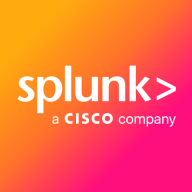

PRTG Network Monitor and Splunk Observability Cloud both compete in the network monitoring and observability category. PRTG seems to have the upper hand for affordability and simplicity, while Splunk stands out in feature-rich, enterprise-grade solutions.
Features: PRTG Network Monitor is appreciated for its affordability, quick deployment, and comprehensive monitoring across devices without complex customizations. Its focus on quick alerts and vendor support addresses diverse infrastructure needs effectively. Conversely, Splunk Observability Cloud offers powerful real-time troubleshooting capabilities, handling high data volumes with sophisticated analytics. Its integration with cloud environments provides detailed insights into microservices and performance, making it ideal for in-depth analytics and large-scale data management.
Room for Improvement: PRTG Network Monitor could improve by enhancing distributed monitoring capabilities, developing more flexible and detailed dashboards, and expanding cloud-native support. On the other hand, Splunk Observability Cloud could benefit from an improved user interface, better data integration options, and a more seamless data import process. There's also a request for precise AI-driven analytics and enhanced support for varied technical environments among its users.
Ease of Deployment and Customer Service: PRTG Network Monitor is noted for easy deployment in on-premises environments, with a straightforward setup. However, its technical support has been criticized for occasionally being slow. Splunk Observability Cloud, while requiring expertise for setup due to its range of features, is supported by comprehensive documentation and broad support networks. Its responsive customer service is appreciated, but ongoing support may be necessary due to the complexity of its offerings.
Pricing and ROI: PRTG Network Monitor offers affordable tiered pricing, especially beneficial for small to mid-sized businesses, and provides a strong ROI due to low initial costs and comprehensive coverage without frequent extra fees. In contrast, Splunk Observability Cloud is more expensive but justifies its cost with features catering to enterprises needing detailed analytics and integrations. Users recognize its potential for enhanced visibility and operational efficiency, translating into long-term savings and performance benefits.
It provides accurate data for utilization, allowing us to monitor and optimize our investments in WAN connection capacity.
After introducing PRTG Network Monitor, we have saved time, and it's easy for everybody to monitor everything.
The implementation reduced our employee resources from 20-25 to 5-6 employees.
Using Splunk has saved my organization about 30% of our budget compared to using multiple different monitoring products.
Anyone working in front-end management should recognize the market price to see the true value of end-user monitoring.
I have definitely seen a return on investment with Splunk Observability Cloud, particularly through how fast it has grown and how comfortable other teams are in relying on its outputs for monitoring and observability.
They resolve our queries 24/7.
The setup process is well-documented, making it easy to deploy.
Tutorials are available so I can manage any issue with PRTG Network Monitor easily.
On a scale of 1 to 10, the customer service and technical support deserve a 10.
They have consistently helped us resolve any issues we've encountered.
They often require multiple questions, with five or six emails to get a response.
On a scale of one to ten, scalability is rated as 9.5.
PRTG Network Monitor has the ability to scale and add new devices.
You can install them in each network, even if they are not connected, and it works.
We've used the solution across more than 250 people, including engineers.
As we are a growing company transitioning all our applications to the cloud, and with the increasing number of cloud-native applications, Splunk Observability Cloud will help us achieve digital resiliency and reduce our mean time to resolution.
I would rate its scalability a nine out of ten.
We haven't needed vendor support for the last three years, which demonstrates the product's stability.
PRTG Network Monitor is stable in my experience, and I have not encountered issues with crashes or downtime.
PRTG Network Monitor is very stable and requires low maintenance.
I would rate its stability a nine out of ten.
We rarely have problems accessing the dashboard or the page.
Unlike NetScout or regular agents for APM, RUM has many problems during the POC phase because customer environments vary widely.
The initial auto-discovery added too many unnecessary sensors, so auto-discovery should only take the necessary sensors into consideration.
They need to improve application performance monitoring, error tracing mechanisms, and log management.
PRTG Network Monitor should provide syslog monitoring since it is not available at this time.
The out-of-the-box customizable dashboards in Splunk Observability Cloud are very effective in showcasing IT performance to business leaders.
The next release of Splunk Observability Cloud should include a feature that makes it so that when looking at charts and dashboards, and also looking at one environment regardless of the product feature that you're in, APM, infrastructure, RUM, the environment that is chosen in the first location when you sign into Splunk Observability Cloud needs to stay persistent all the way through.
There is room for improvement in the alerting system, which is complicated and has less documentation available.
The licensing part is a recurring license for every year, which is very affordable, making PRTG Network Monitor budget-friendly.
Pricing is by the number of devices, not by sensor.
The prices are very high for PRTG Network Monitor.
Splunk is a bit expensive since it charges based on the indexing rate of data.
It is expensive, especially when there are other vendors that offer something similar for much cheaper.
It appears to be expensive compared to competitors.
PRTG Network Monitor already provided me with 100 free sensors, which is enough for my network monitoring.
PRTG Network Monitor has a good dashboard that shows each and every piece of information, so we can easily find out what is happening with the systems.
These reports help me in my day-to-day work, and I rely on them because they provide proof during escalation, with exact downtime logs and related information.
Splunk provides advanced notifications of roadblocks in the application, which helps us to improve and avoid impacts during high-volume days.
For troubleshooting, we can detect problems in seconds, which is particularly helpful for digital teams.
It offers unified visibility for logs, metrics, and traces.
| Product | Market Share (%) |
|---|---|
| PRTG Network Monitor | 3.5% |
| Splunk Observability Cloud | 1.3% |
| Other | 95.2% |


| Company Size | Count |
|---|---|
| Small Business | 59 |
| Midsize Enterprise | 19 |
| Large Enterprise | 47 |
| Company Size | Count |
|---|---|
| Small Business | 20 |
| Midsize Enterprise | 10 |
| Large Enterprise | 46 |
PRTG Network Monitor runs on a Windows machine within your network, collecting various statistics from the machines, software, and devices which you designate. PRTG comes with an easy-to-use web interface with point-and-click configuration. You can easily share data from it with non-technical colleagues and customers, including via live graphs and custom reports. This will let you plan for network expansion, see what applications are using most of your connection, and make sure that no one is hogging the entire network just to torrent videos.
To monitor a large IT environment, it's important to be able to scale PRTG up. Paessler PRTG Enterprise Monitor includes all the proven capabilities of PRTG Network Monitor, which are enhanced by exclusive ITOps Board for a service-oriented, central overview of multiple PRTG servers.
Splunk Observability Cloud offers sophisticated log searching, data integration, and customizable dashboards. With rapid deployment and ease of use, this cloud service enhances monitoring capabilities across IT infrastructures for comprehensive end-to-end visibility.
Focused on enhancing performance management and security, Splunk Observability Cloud supports environments through its data visualization and analysis tools. Users appreciate its robust application performance monitoring and troubleshooting insights. However, improvements in integrations, interface customization, scalability, and automation are needed. Users find value in its capabilities for infrastructure and network monitoring, as well as log analytics, albeit cost considerations and better documentation are desired. Enhancements in real-time monitoring and network protection are also noted as areas for development.
What are the key features?In industries, Splunk Observability Cloud is implemented for security management by analyzing logs from detection systems, offering real-time alerts and troubleshooting for cloud-native applications. It is leveraged for machine data analysis, improving infrastructure visibility and supporting network and application performance management efforts.
We monitor all Network Monitoring Software reviews to prevent fraudulent reviews and keep review quality high. We do not post reviews by company employees or direct competitors. We validate each review for authenticity via cross-reference with LinkedIn, and personal follow-up with the reviewer when necessary.